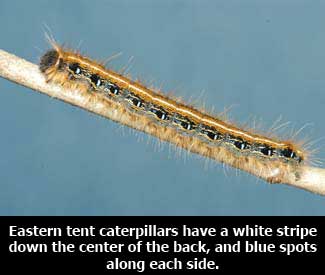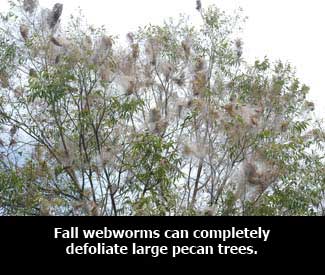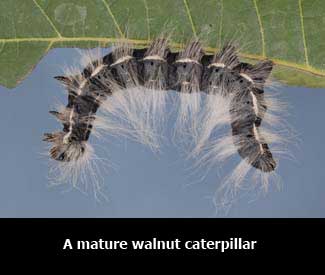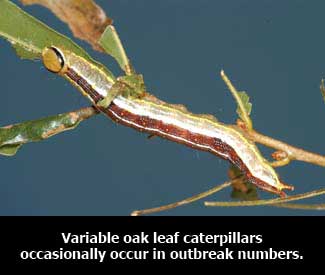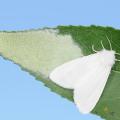Caterpillar Pests of Trees
There are many species of caterpillars that attack hardwood trees in urban landscapes. Fortunately, outbreaks are sporadic and are often limited to certain species of trees and certain times of the year. For example, the angular webs of eastern tent caterpillars are common on black cherry trees, and occasionally on other Prunus spp., as well as apples and other fruit trees, in early spring. Outbreaks of forest tent caterpillars, which despite their name do not build tents, occasionally cause severe defoliation of oak trees in the spring, but fall webworms, which restrict their attacks to pecan and persimmon, are more common in late summer and fall. Walnut caterpillars also attack pecan trees, occasionally causing complete defoliation of a single limb or area of a tree. Walnut caterpillars do not build tents or webs, but they often cluster together on the trunk when it is time to molt (shed their skin), leaving a hairy mass of shed skins behind. Variable oak leaf caterpillars occur sporadically across the state, but outbreaks are sometimes severe enough to cause heavy defoliation of oaks in mid-summer. Many other species of caterpillars occur on hardwood trees in the state, but control recommendations are similar regardless of the species of caterpillar and tree.
Control Caterpillars in Trees: In most cases it is not practical to try to control caterpillar pests that are defoliating large trees. Most homeowners simply do not have the equipment needed to effectively treat large trees, and in urban settings, the risk of off target spray drift is usually too great to permit spray applications even if equipment is available. In addition, many caterpillar outbreaks have nearly run their course by the time damage is detected. Large caterpillars that are wandering about on the ground have usually finished their caterpillar life and are looking for a place to pupate (form their cocoon). Fortunately, broadleaf trees are quite tolerant of defoliation and well established, properly watered trees will usually recover from caterpillar-induced defoliation even when leaf loss is complete. Young, recently planted trees are more susceptible, but are also easier to treat. To control caterpillar outbreaks on small trees, spray with a product containing the active ingredient spinosad using an appropriate power sprayer or a hose-end tree and shrub sprayer (Fertilome, Bonide, and Monterey companies all sell spinosad products). Some insecticides (such as abamectin and emamectin benzoate) can be applied by properly licensed commercial applicators as trunk injections to control caterpillar pests on large, high value trees in sensitive urban settings. However, such treatments are costly and must be applied before caterpillars become large enough to cause excessive defoliation.
See Insect Pests of ornamental plants in the home landscape, page 18-22 and pages 39-41 for more information on caterpillar pests of trees.
Publications
News
A grant from Coast Electric will allow for a renovation of the Mississippi State University Crosby Arboretum’s pollinator garden. Pat Drackett, director of the arboretum, said the pollinator garden was established in 2001 as the Explorers’ Garden. It is a 3,000-square-foot space with a variety of native and other plants that helps teach visitors how to create havens for pollinators.
The 2020 Fall Flower & Garden Fest will be a virtual, educational event this year.
A tent for camping in the woods can be a good thing, but a tent filled with caterpillars in a pecan tree can be bad news for homeowners.


